Whale hello there! Humpback whale behaivours
As we dust off our dive gear and begin to travel, there’s a good chance you may come across some humpback whales. Here’s what you need to know about their behaviours…
Words and Photography By David Fleetham
Humpback whales are found in all the world’s oceans and are often a vacation highlight for snorkellers, divers, and freedivers. From Austailia to Alaska, British Columbia to Japan, Hawaii to the Dominican Republic. Humpbacks have entertained many a dive boat through the years.
As a resident of Hawaii—along with the millions of tourists that take their vacation here—I get to witness many of the around ten thousand of these gargantuan visitors annually. After feeding on the West Coast of North America for the summer, they make the journey across the Pacific some time in December and are seen around all the Hawaii islands through until April. If you are fortunate enough to witness their natural behaviour firsthand, no matter what country you’re in, here are some things to watch out for.
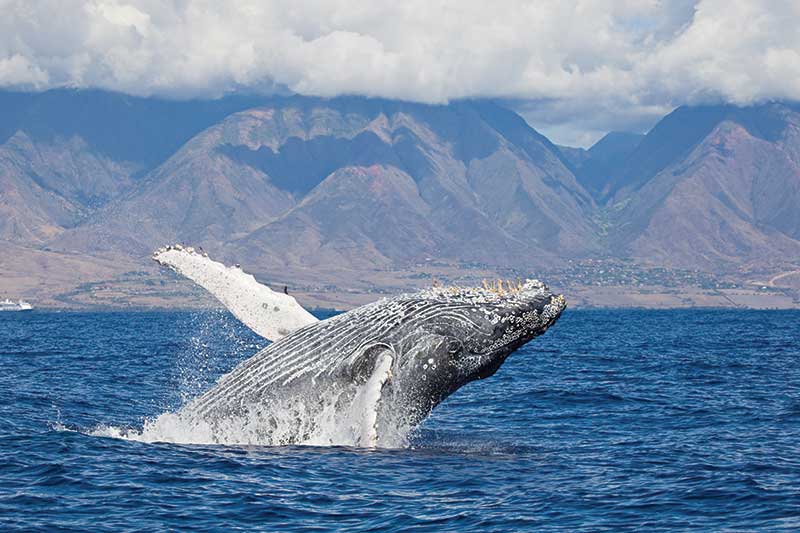
A breaching humpback whale with the West Maui Mountains in the background. Photo: David Fleetham
Breaching
Breaching is by far the most spectacular humpback performance. At around 30 tons (30,000kg) and 45 feet (14m) long, it seems surreal that these giants can even accomplish this feat. Yet underwater observers who have seen what takes place below the surface concur that it only takes a few strokes of their powerful tails to propel them into the air. Why do they breach? Theories range from looking at their surroundings above the surface, communicating with other whales, to removing barnacles, and my favourite… because it feels good!

Tail Slapping
Humpbacks will sometimes repeatedly lift their enormous tail flukes into the air and slam them back down to the surface, creating a huge splash and a loud smacking sound that can be heard both above and below the surface. At fifteen feet (4.5m) across, this tail can be a powerful tool and is often used in aggressive groups.
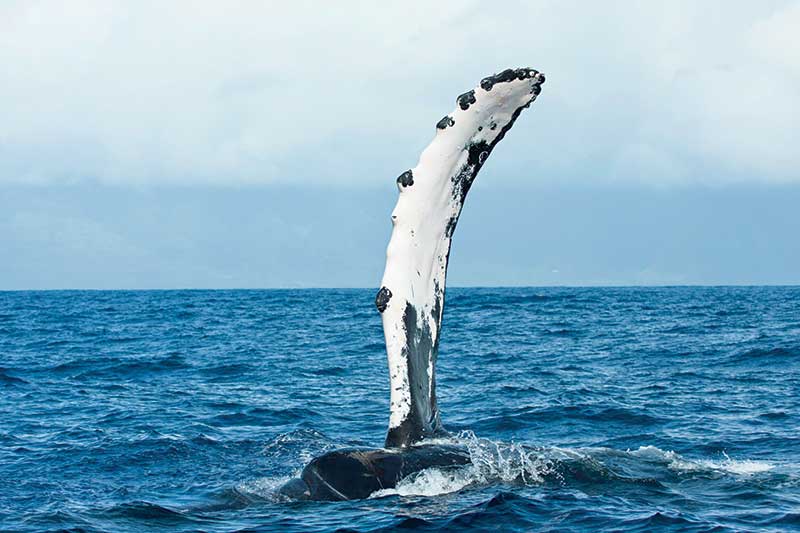
Pectoral Slapping
Of all the whales, humpbacks have the longest pectoral fins in ratio to their body size. These fins are thought to aid them in manoeuvring underwater. On the surface, they will lay on their sides, lift these fins into the air until they are vertical, and then slap them down to create a loud smacking sound.
Blow (breathing)
Whales are divided into two groups, baleen whales and toothed whales. Among several differences, one is the whale’s blowhole. Toothed whales have one opening on the top of their head, whereas baleen whales like humpbacks have a pair of openings. Water on the blow hole is vaporized and shoots 20 to 25 feet (6 to 7.5m) into the air creating the ‘blow’, or spout. In the case of humpback whales with their dual opening, this is a ‘V’-shaped formation. On a calm day, the vapour can hang in the air for quite some time and makes the location of the whale visible from several miles away. By measuring the lung capacity of an adult humpback whale, the diameter of the whale’s blowhole and the time it takes for an exhalation, scientists have calculated that the air moves at around 700 miles per hour (1125 km/h), so don’t put your face directly over this opening! Whales will usually take three to six breathes before diving back under.
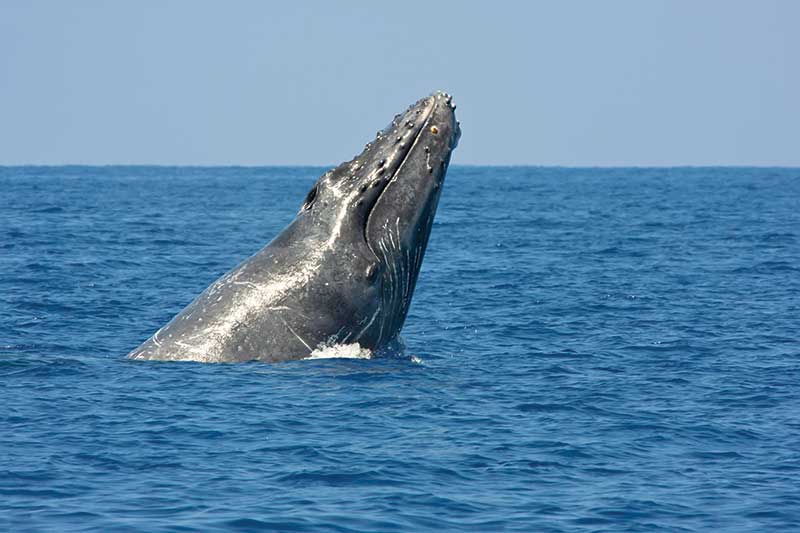
Spy Hop
A humpback whale’s eyes work well both above and below the surface. Often when vessels approach an area where whales are present, one individual will propel itself vertically out of the water so that its eye is well above the surface. It will hold this pose for a moment before sinking on the same vertical path back below. This allows the whale to see who is approaching and sometimes a whale will do it right beside a whale watching vessel. It makes you wonder, who is watching whom?
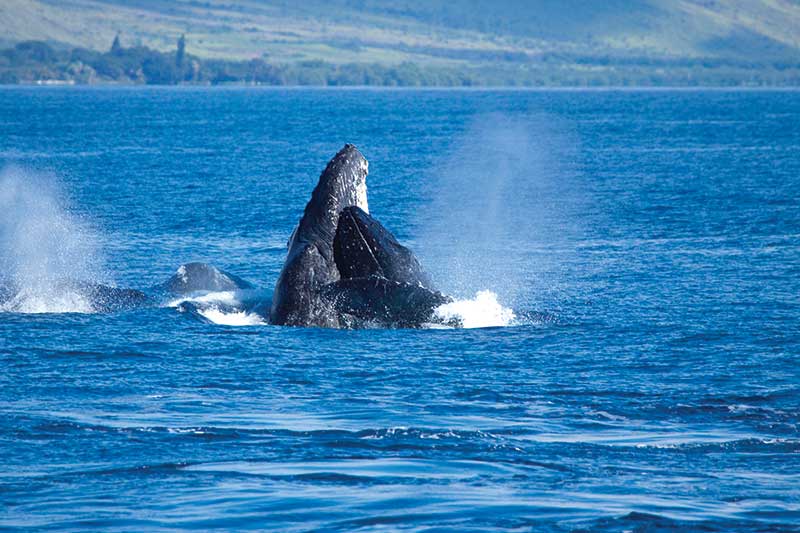
a female. Photo: David Fleetham
Courting
Humpback whales around the world travel to warm waters to give birth and mate. The mating portion involves a preceding behaviour known as a competitive group or pod. This has been equated to a similar human behaviour, with a variable size group of males perusing a single receptive female. In the case of the whales, this can often be a fast-moving and dynamic display involving several behaviours. An extremely aggressive group of males might smash into each other to the point of bloodshed. They may pound each other with their tails, head lunge on other males, and even breach on each other. All this to impress a single female who may travel in a straight line or zig zag across miles of ocean, often at a good clip.
Fluke Up Dive
Many aspects of the humpback whale remain a mystery, since these animals spend most their time underwater. This can also make whale watching an effort in frustration, so along with a hat, sunblock, and binoculars, bring your patience with you. The down time ranges from 5 to 15 minutes for the most part, but they can dive for over 45 minutes, although this is unusual. Once on the surface, whales will take several breaths before disappearing below. Between breaths you will see the whale’s dorsal fin and back until after its final inhalation and it dives. At this point the whale will lift its massive tail into the air, using gravity to drive it down to depth.
Singing
Many species of whales, and dolphin as well, are vocal. However, only humpback whales produce a unique series of sounds that are repeated in a pattern to truly create a song. The more this phenomenon is studied, the more questions arise. Whales have no vocal cords, so no air is released, and it is not fully understood how they are even capable of producing the sounds they do. They may force air back and forth through various openings and sacks in their respiratory system. For the most part, it is thought that the singing is limited to males, who perform alone. They often sing 30 to 60 feet (9 to 18m) below the surface in a stationary head-down, tail-up position. The song lasts for 12 to 18 minutes and may be repeated two or three times. Most incredible is the fact that all the whales in Hawaii sing the same song and as the season progresses the song changes. Humpbacks in the north Pacific population winter not only in Hawaii, but also travel to Japan and down to Baja, Mexico. And they all still sing this same melody. Why they sing is just another aspect of this mysterious behaviour. For communication? To designate territory? Attract females? Warn other males? What’s your guess?
Feeding
Baleen whales feed by opening their gargantuan mouths to engulf huge amounts of water, as much as 500 gallons (2300 litres), containing their prey of krill and small fish. Krill are tiny shrimp-like organisms and the fish are mostly herring and small mackerel. Hawaii’s blue water is crystal clear due to a scarcity of phytoplankton, the food that krill and herring feed on. No phytoplankton means no food for humpback whales. For this reason, the humpbacks stuff themselves in the nutrient-rich feeding ground of Alaska’s waters. They consume somewhere between 2000 to 9000 pounds (900 to 4000kg) of food per day while they are in the summer feeding grounds and store a good portion of this as fat, which must last them on the long migration to and from Hawaii, as well as the 100 to 150 days that they spend here. It is not known if they feed while travelling, but it is assumed that if the opportunity were available, they would take advantage of it. What is known, is that the calves that are born in Hawaii do feed, and actually dine very well. When born, calves are around 13 feet (4m) in length and can weight two tons. They down over 100 pounds (45kg) of mom’s milk each day—a tough trick for a fasting mother! By the time they are weaned, 5 to 7 months after birth, the youngster will have doubled its length and increased its weight five-fold, to a whopping 10 tons.
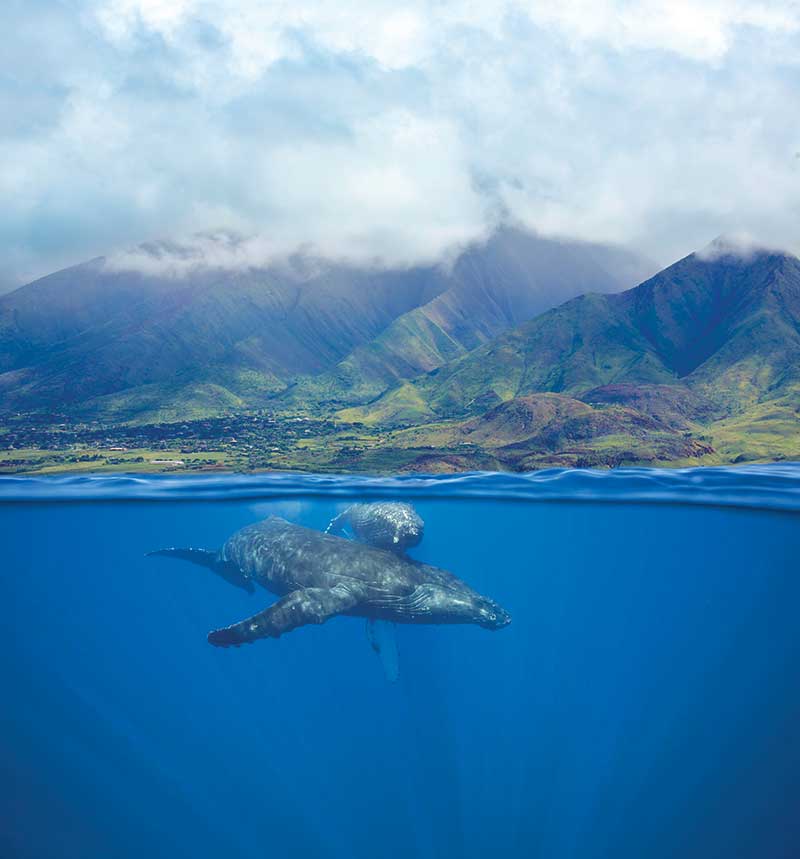
Sleeping
Humpback whales lead a life that is not without threats, including sharks, entanglements from floating marine debris like nets and long lines, and the constant hazard from boats. With all this they have evolved a unique form of slumber. They are able to put half of their brain to sleep, with the remaining half acting as a sentry to be conscious of possible danger. Once the first half is well rested, they switch to allow the other half the same respite.
Peduncle Throw
Also known as lobtailing, a peduncle throw is an aggressive manoeuvre often seen between competing males and occasionally by a female who is unhappy with her escort. As the whale is moving on the surface, it will abruptly put on the brakes with its long pectoral fins, point its head downward and at the same time lift its tail fluke and peduncle (the muscular portion of the whale that connects the fluke to the torso) into the air. This powerful segment of humpback is then thrust sideways onto the unfortunate target.
Wherever you head on your post-pandemic dive vacation, there’s a good chance humpbacks may be visitors to the area. Make sure you have a long lens on your camera, and a sharp set of eyes. Keep those ears open too, you may even be lucky enough to hear one singing on your next dive.
Leave a Comment







